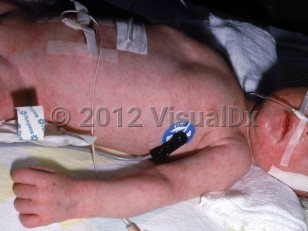Argininosuccinic aciduria
Alerts and Notices
Important News & Links
Synopsis

Also called argininosuccinate lyase deficiency, a life-threatening urea-cycle metabolism disorder due to autosomal recessive inheritance of mutated ASL gene. Characterized by hyperammonemia.
Within days of birth, infant may display lethargy, poor feeding, somnolence, hypothermia, tachypnea, vomiting, and failure to thrive. Severe neonatal-onset form may lead to seizures, coma, and death if left untreated. A milder, late-onset form may be triggered by infection or stress and present recurring episodes of hyperammonemia, with vomiting, irritability, behavioral dysfunction, hepatomegaly, trichorrhexis nodosa (dry, brittle hair), intellectual disability, and developmental delay.
Management includes treatment of hyperammonemia by arginine therapy and reduction of oral protein. In resistant cases, hemodialysis may be considered.
Within days of birth, infant may display lethargy, poor feeding, somnolence, hypothermia, tachypnea, vomiting, and failure to thrive. Severe neonatal-onset form may lead to seizures, coma, and death if left untreated. A milder, late-onset form may be triggered by infection or stress and present recurring episodes of hyperammonemia, with vomiting, irritability, behavioral dysfunction, hepatomegaly, trichorrhexis nodosa (dry, brittle hair), intellectual disability, and developmental delay.
Management includes treatment of hyperammonemia by arginine therapy and reduction of oral protein. In resistant cases, hemodialysis may be considered.
Codes
ICD10CM:
E72.22 – Arginosuccinic aciduria
SNOMEDCT:
41013004 – Argininosuccinate lyase deficiency
E72.22 – Arginosuccinic aciduria
SNOMEDCT:
41013004 – Argininosuccinate lyase deficiency
Best Tests
Subscription Required
References
Subscription Required
Last Updated:10/06/2022

